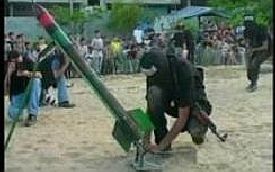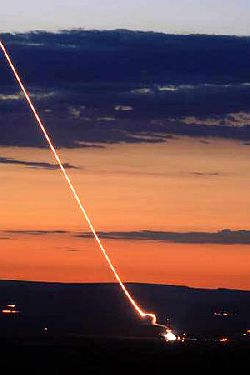.


Commentary;
The Olmert, Barak, Ramon regime will stop at nothing; sanctions, short-range missile interception systems, etc. in order to avoid doing what needs to be done — to eliminate the weapons smuggling, manufacture and the army which launches the missiles in the first place.
Former defense minister Moshe Arens writes (excerpt of full article below);
One does not have to be a rocket scientist or nuclear physicist to understand that the shorter the range of the ballistic missile to be intercepted, the more difficult interception becomes. When our defense minister announces that within two and a half years we will have an operational interception system against Kassam rockets – rockets which have a range of only a few kilometers – one should wonder whether this is a reasonable time scale and whether the Defense Ministry’s estimates on how much this will cost are correct.
In short, as this author once wrote before the expulsion about the various costs, lost economic agricultural revenues as well as the costs of the military expulsion action, the compensation costs, the costs entailed in military actions directly attributable to Islamic missile launching capabilities from sites in former Jewish communities, etc.; the words of an old George Michael tune seem apropo for Israelis; “Watch out, Baby, Who’s That? — Don’t Look Now, There’s a [Tax] Monkey on Your Back!” MB
Intercepting Kassam Rockets, by Moshe Arens (Haaretz)
Full Text;
Toward the end of World War II, when the Germans began launching V2 rockets against London from sites in Belgium and Holland, the only way to neutralize the threat was for Montgomery’s army to reach the launching sites and move the rockets out of range. There was no way of intercepting these rockets in midair, and 1,400 V2 rockets landed in England – most of them hitting London – before Montgomery’s army succeeded in reaching the launching sites. As the world entered the missile age during the Cold War, the strategy of the U.S. and the Soviet Union was based on the understanding that intercepting ballistic missiles was a technical impossibility.
This assumption was shattered by Ronald Reagan, when in an address to the nation on March 23, 1983, the president advocated the development of missile interception systems. “What if free people could live secure in the knowledge that we could intercept and destroy strategic ballistic missiles before they reach our soil? There will be failures and setbacks, just as there will be successes and breakthroughs,” he announced.
Thus the Strategic Defense Initiative, frequently referred to as “Star Wars,” was born. The U.S. defense budget was increased by more than a third, and a vast scientific and technological effort was launched. Now, 25 years later, an American anti-ballistic missile system is finally approaching operational status.
It has been argued that Reagan’s initiative was instrumental in ending the Cold War by ratcheting up American defense expenditures to a point beyond the Soviets’ economic capability to match. Long before the U.S. achieved the capability to intercept ballistic missiles, Reagan and Soviet leader Mikhail Gorbachev signaled the end of the Cold War at their meeting in Reykjavik in October 1986.
Since then, Israel’s Arrow system, developed with the aid of funding from the U.S. Strategic Defense Initiative, has proven that ballistic missiles can be intercepted. The system became operational some years ago. At the time there was no shortage of opponents to the Arrow’s development in the Israeli military establishment, including some who currently fill senior positions. It took my insistence as defense minister at the time to prevent the cancellation of the program.
One does not have to be a rocket scientist or nuclear physicist to understand that the shorter the range of the ballistic missile to be intercepted, the more difficult interception becomes. When our defense minister announces that within two and a half years we will have an operational interception system against Kassam rockets – rockets which have a range of only a few kilometers – one should wonder whether this is a reasonable time scale, and whether the Defense Ministry’s estimates on how much this will cost are correct.
These issues need to be debated, and the government has to present its policy and the assumptions underlying that policy. The Kassam interception system the government is funding is presumably the answer to the travails of the people of Sderot and the settlement surrounding the Gaza Strip. Can they be expected to wait two and a half years while Kassams land on their homes? Is this consistent with the government’s responsibility to assure the safety of the civilian population? And what if the time required for the development and achievement of operational status has been underestimated by the minister of defense, possibly by a wide margin?
And the cost. It will certainly exceed by far the minister’s current estimates. Although the cost of this ambitious program is not likely to threaten the stability of Israel’s economy – as Reagan’s initiative threatened the Soviet economy 20 years ago – the money allocated to the Kassam interceptor program will mean smaller allocations to other military and civilian needs, and may very well not be a wise allocation of Israel’s resources.
One thing must be handed to the terrorists in the Gaza Strip. Using primitive, cheap rockets, they have forced the Israeli Defense Ministry to allocate billions to the development of a system which may or may not be the answer to the Kassam rockets. They are not only endangering the lives of the residents of Sderot, they are making a significant dent in the Israeli economy.